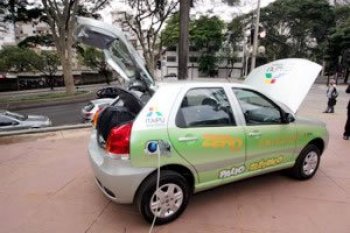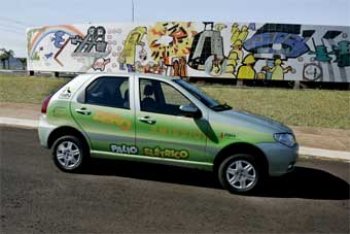|
The
zero-emission Fiat Palio
Elétrico, a joint research venture between Fiat
Brazil, a national energy giant and a huge hydroelectric dam
concern, is now set to be put into limited production after
successful initial trials.
The car is the result of a 5-year project and
it has been
demonstrated around Brazil since being unveiled in June of
last year. The ambitious programme saw Brazilian
electric-generating energy concern Companhia Energetica de
Minas Gerais (Cemig) and Itaipu Binacional, who operate the
world's largest hydroelectric dam project, teaming up with
the Research & Development arm of Fiat Automóveis, which has
also involved Magneti Marelli in Brazil and Centro Ricerche
Fiat (CRF) in Turin, to realise a zero-emission car that
could be cost-effectivly priced and practical to manufacture. The three partners
have spend around 3.4 million reals (US$1.8 million) on the
programme so far.
The resulting prototype, dubbed as
the Palio Elétrico, puts out 15 kW
(20 CV) and a maximum 50 Nm of torque. Being electric the car offers the
advantage of emitting no noise on the road. Top speed is a
respectable 105 km/h while the car weights in
at just 600 kg, with the electric motors being 42 kg and the batteries 165 kg.
The replacement of the engine with the compact electric
motor has improved weight distribution: now 48 percent is
concentrated at the front compared to 63 percent on the
1.0-litre standard model. The conventional gearstick
arrangement has been replaced with a 3-position lever
offering the driver the option of drive, neutral and
reverse. A new instrument panel offers the driver useful
information on the electrical system including battery life,
load and temperature. The brake servo is now electrically
operated.
The nickel batteries used the Palio
Elétrico are produced in Switzerland by KWO, who have been closely involved in
the project from the beginning. The batteries are located in a reinforced
section (designed for maximum safety in major accidents)
under the boot floor where the spare wheel well is situated,
and in final production form they are expected not to make
any additional demands on the existing loading space.
The batteries
are recharged through an electric plug (able to hook up to
any household cable though a typical wall socket) which is
positioned behind the flush fitting flap where the
production Palio's fuel filler pipe is usually located. A
110V or 220V power supply can be used for charging, and just
16A is required (less than needed by a household shower)
with the batteries heated to 270 degrees centigrade before
charging commences. Charging can also be undertaken in any
number of short bursts without any damage to the batteries.
|
 |
|
The Palio Elétrico is
recharged through an electric plug (able to hook up
a household cable) which is positioned behind the
flush-flap where the production model's fuel filler
cap is usually located. |
|
 |
|
|
 |
|
The
zero-emission Fiat Palio Elétrico prototype, a joint
research venture between Fiat Brazil, a national energy
giant and the world's largest hydroelectric dam, is set to
be put into limited production. |
|
 |
|
|
To address the toxic concerns associated with nickel
batteries they will be part-recyclable and
part-biodegradable. At present one drawback of this electric
car project is the 8-hour full recharge time needed, but all
partners in the project are pushing forward to develop
technology which will reduce the time involved. They are
rated at a life of 150,000 kilometres. Fully charged the
range is 110 kilometres in the extra-urban cycle or 120 km
in the urban cycle. Its range advantage around town is due
to a small alternator that charges the batteries when in
decelerating mode. This function can be activated by the
driver via a dashboard-located button and up to 20 km can be
added to the range through this. KWO are presently
evaluating building a new factory located near Fiat's Betim
plant in the Minas Gerais state to manufacture the
batteries.
Now after
significant trials, 30 examples of the Palio Elétrico will be
built for use by Cemig at its energy plants. Cemig today
operates 48 power plants, of which 44 are hydroelectric, 3
are fuel-oil thermal plants while the last one is a small wind power plant,
all of them totalling an installed capacity of 5,704 MW. "Up
to 2008, the goal is for this to become a viable prototype,
to harmonise parts, to lower costs, to increase autonomy and
to lower the recharge time," said Carlos Eugęnio Dutra,
Fiat Automóveis' Product Director.
One of the main
objectives of the project is to convince Brazilian car
buyers that electric vehicles (EV) are a viable option in
the showrooms and that they don't need to run vehicles that
rely on fossil fuels. EVs have now topped 300,000 units
sales per year in Europe and many cites offer this type of
vehicle fiscal advantages, such as in London where they
attract lower levels of taxation and are exempt from the
inner city's 'Congestion Charge'.
Itaipu has been
involved in EV projects for five years and since 2005 it has
worked in partnership with Cemig who have supported the
large investments required to realise programmes in this
area. These two firms have been working with Fiat Automóveis
and its own technical partners as well as CRF. The parties
expect electric cars to become economically feasible and
more widely accepted by Brazilian car buyers around 2011-12.
Economies of scale and technological advances expected to be
made in the next 5 years will help to bring overall
production costs down.
|
|
|
|